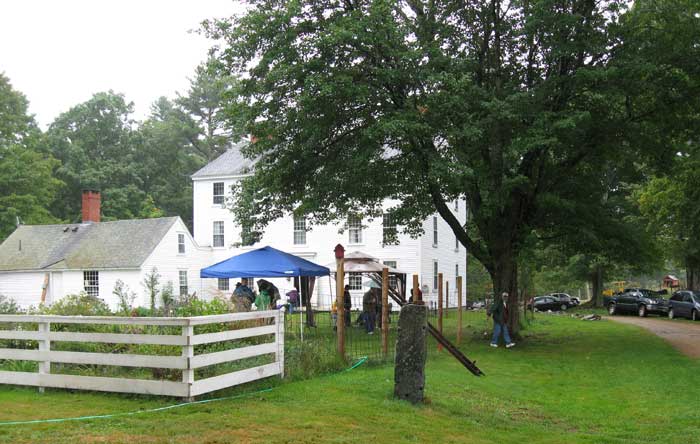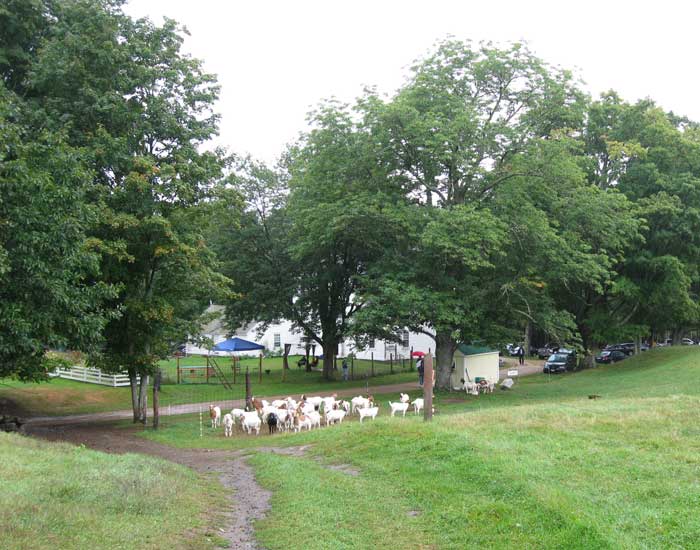Journals and Travelogues
Our Canterbury Tale
A related blog: "Glorious Garlic" is shared in the final panel on this page.
Please note that these are long entries; each panel has a scroll bar at left.
Index
Authorship
Journals/Travelogues
Girl Scout Trip
The Doan Sisters Go to England
Our Canterbury Tale
A Family Tradition!
Boot Saddle, to Horse and Away!
The Lot
The Silent Generation
With Daniel Doan:
The Diary Man & Hiking Guides
Indian Stream Republic (editor)
Authorship as a Profession
A Clean, Well-Lighted Place
Writers Ultimately Live in Imaginary Places
A Blank Page
Aunt Pleasantine
Remember the Reader
Book-Reviewing
Sequel Reader
Desks
Writing A BORN MANIAC
For Book Clubs
THE CHEERLEADER: A Book Club Guide
(A PDF that can be downloaded and printed as a booklet) for distribution to book club participants)
Our Canterbury Tale
September 19, 2009
Whan that Aprille with his shoures soote . . .
Then longen folk to goon on pilgrimages . . .
And specially, from every shires ende
Of Engelond to Caunterbury they wende,
The holy blisful martir for to seke—
Well, actually it was September, and what Don and I were seeking was garlic.
Last year, my friend Gwen Newton, knowing that I grow garlic, sent me a newspaper article about Garlic Days that had been celebrated down at Two Sisters’ Garlic on a farm in Canterbury, New Hampshire. They had held the first garlic festival in 2004, but somehow I’d missed hearing about it or the subsequent ones. I’d read about the garlic festivals in Gilroy, California, “The Garlic Capital of the World,” and Penny, my sister, had given me a Gilroy cookbook, The Garlic Lovers’ Cookbook. But I’d never dreamed there’d be a garlic festival in New Hampshire! I immediately resolved to go in 2009.
This summer I Googled “Two Sisters’ Garlic Day” and found the date, September 12. I wrote “Garlic Day” large on our calendar.
When the day arrived, the weather forecast said casually, “Mostly cloudy with a couple of showers.” Thinking we might be overly cautious, we tossed our raincoats in the backseat before left. Good thing we did. Steady rain soon began falling, and it poured throughout the day.
Canterbury, New Hampshire, is famous for its Shaker Village, to which we’d once been. As we drove past the road to that enclave of beautiful white buildings and headed for Canterbury Center, we realized that we were experiencing a rare exhilaration for natives of a certain age, seeing a part of our home state that we’d never seen before—at least not when we were grown up enough to remember. The scenes were new to us, rural in a softer curving way than our mountain valley. When we reached the center, we spotted the garlic-scape signs that the online directions had told us to look for, the curlicue scapes pointing like arrows. Note: In “Glorious Garlic,” a piece I wrote for “Ruth’s Neighborhood” ten years ago, I mentioned that when “bulbils” formed I cut them off and threw them on the compost pile, following the usual garlic-growing instructions. Then, two years ago, at a farmers’ market in our village I saw Diane and Peter Booty selling bulbils at their stand! Peter explained that they’re called scapes and told me how delicious they are, raw or cooked. I rushed home to yank mine off the compost pile and look up scapes in the dictionary. The next year my friend Gloria Pond sent me a New York Times article with elaborate garlic-scape recipes and told me of seeing “great lariats” of garlic scapes at her Connecticut farmers’ market, so it dawned on me that scapes were definitely in vogue and I realized ruefully that I’d been throwing away a gourmet delicacy all these years. Don and I followed the curlicue signs out of the center and onto a dirt road through misty green woods, a good old-fashioned dirt road, the likes of which we drive a lot in Sandwich; indeed, the road we live on is more dirt than paved. However, this one, being unfamiliar, got me a little nervous, and I remembered my mother’s complaint that my father could find a dirt road in the middle of Boston.

Then into sight through the rain came a high square white house, and we saw at the side of the road, in front of a field where cars were parked, a man with a table of umbrellas. After we parked and pulled on our raincoats, we walked back to him and accepted the loan of an umbrella, completely forgetting the old collapsible one we keep stored in the car. When we commiserated about the weather, he told us that there was a much more serious problem:
Continues . . .
Continued from page 1
Page 2

The garlic crop had been spoiled by mold. Shock. In their online description of their wares, the Two Sisters had written, “The 2009 stock is drying in the barn! Looks great and uncured garlic bulbs are now for sale. Two Sisters’ Garlic invites you to join us celebrating the 2009 Garlic harvest! All day garlic tasting, garlic smells, garlic sights, garlic information, and garlic to buy.” The weather this summer has been terrible, cold (Penny turned on her furnace on her July birthday, for the first time ever), with record-breaking rainfall during June and July. My garlic, planted last October, had shot up crisp and green in early spring and then sat miserably in mud for months, shivering along with everything else in the garden. When I harvested the bulbs in August, some were smaller than usual. They dried for about a month on ceiling hooks on the porch, my latest method, and I recently bagged them for storage. They seem okay, knock on wood. My heart broke for the Two Sisters.
The sisters, Naomi Scanlon and Abby Ladd, have made garlic the main crop of the Clough Tavern Farm, which had been in the Clough family from 1735 to 1951. The original house became the ell of the main house, a tavern built in 1777. The Cloughs built the first gristmill and sawmill in Canterbury. In 1961 the Scanlons bought the homestead, and on its 130 acres they raise Boer X goats, Scottish Blackface sheep, and garlic. As they say in their brochure, “The Garlic is the focal point of our farm, supporting supporting the other farming endeavors. Our goal is to build a sustainable agriculture business that will provide our customers with the highest quality bulbs and products.” The newspaper article had told me that they harvest over 400 pounds of garlic and produce over 2,500 jars of garlic jellies to be used as condiments or hors d’oeuvres.
Don and I walked around the side of the house past a stand where two daughters were selling coffee and doughnuts, which folks were consuming under a tent while a child with an eager border collie on a leash went exploring. The flock of goats in a field observed the proceedings, but the sheep were in the barn. We walked up a hill to get a better view of the place, all green and wet, its history hovering, the centuries of farming.
Then we went shopping. I had hoped to buy some of their bulbs to give my crop new blood, so to speak. But none could be sold this year. Instead, in the house we chose Rosemary Ginger Garlic Jelly and Mint Garlic Jelly from a cupboard display. The sisters also make Red Pepper Garlic Jelly and Simply Garlic Jelly, as well as bottles of dried and ground garlic and herb-spice blends.
Back outdoors, we stopped at the coffee stand for sustenance. There was no modern “baked” doughnuts nonsense here. The doughnuts were being fried in a skillet of fat. And the garlic theme didn’t extend this far. These doughnuts, with a hint of cinnamon, tasted like the ones Penny and I used to make in a cast-iron frying pan, our mother keeping a watchful eye. We talked with the daughters and got directions about how to go home via a different route to see more new scenery.
This, after returning the umbrella to the umbrella man, we did. We drove on past the farm to the Old Tilton Road, a quiet country road that looped back and forth a couple of times underneath the interstate where the Saturday traffic thundered.
And then we were in Tilton, on a strip of malls, and we stopped at Staples.
I hope that the Two Sisters can salvage enough of their garlic or buy some to plant this fall for next year. I’ll be Googling next summer in hopes of a 2010 Garlic Day.
© 2009 by Ruth Doan MacDougall
All rights reserved
2024 note: Two Sisters' Garlic is still sold in NH by Clough Tavern Farm in Cadbury.
Next: "Glorious Garlic," a "Ruth's Neighborhood entry mentioned earlier in this "Canterbury Trip" essay.
Continues, page 3
Continued from page 2
Page 3
Glorious Garlic
I never had any luck growing garlic until a few years ago when we met one of Don's former students, Andrea Craxton, and her husband, David, who live on an organic farm in northern New Hampshire. David, we learned, is known as the Garlic King.
Aha, I thought, and begged -for advice. Andrea gave me a copy of an article she'd written for The Northern Beacon about the King's garlic-growing methods. Adapting them to my smaller garden, I at last found success, which still strikes me as unbelievable.
Every Columbus Day I plant rows of garlic cloves, fretting that the little nuggets won't survive the winter. I spread some hay over them, and soon enough there's snow on top. Throughout the winter I gaze out the window beside my desk, seeing snowdrifts across the garden and shivering for those cloves. But early in the spring, as the snow melts down to the layer of frosty hay, green shoots valiantly stab upward. Hooray!
That feeling of triumph never really lessens during the summer while I weed and water and the stalks grow. Those rows of garlic are the most satisfying sight in the whole garden. Along about mid-July, stalks start to curl, forming a small bulb, a bulbil, which I cut off so the main bulbs' energy won't be sapped. A couple of weeks later, the stalks begin to turn brown.
Around the second week in August, I carefully dig up the garlic, shake off as much dirt as possible from the damp bulbs, and lug basketloads up to my office (a garret) where I spread them out on newspapers on the floor to dry.
That's where they are right now, and the aroma is heady as I write.
When they are dry, I'll brush off the remaining dirt, cut off the stalks (this hard-stemmed variety can't be braided), and put the harvest in mesh bags for storage. But I'll set aside the best of the bulbs to replant on Columbus Day, once again doubting their survival.
Copyright 1999 by Ruth Doan MacDougall;
All Rights Reserved
Privacy Policy
This website does not collect any personal information. We do collect numerical data as to traffic to the site, but this data is not attached in any way to our visitors' personal or computer identities. Those clicking through to other websites linked from this page are subject to those sites' privacy policies.
